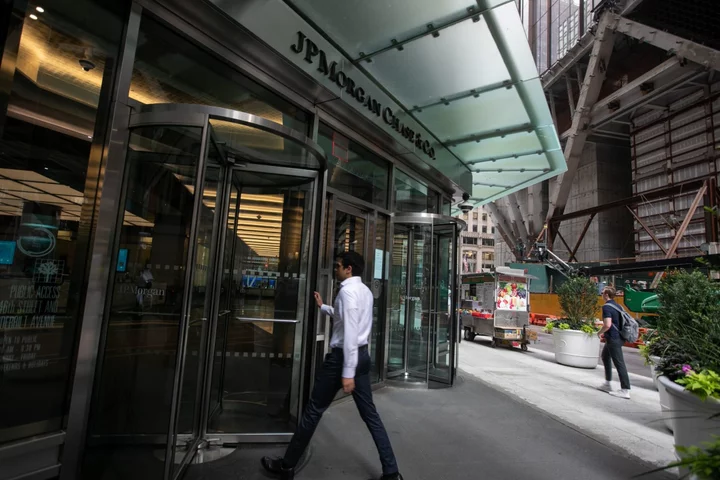JPMorgan Chase & Co. and Wells Fargo & Co. are both tapping the US investment-grade primary market, kicking off a potential deluge of fresh bank bonds in the wake of second-quarter earnings.
JPMorgan is testing investor appetite with a multi-part deal expected to price Monday. Initial discussions related to the bank’s six-year bond, which isn’t callable for five years, are for a yield in the range of 1.5 to 1.55 percentage points over Treasuries, according to a person familiar with the matter. The notes are fixed-to-floating rate.
Wells Fargo is also in the market with the first preferred deal since the regional banking crisis ignited concern over the broader industry. It’s a sign that big banks may look to restart preferred issuance now that perceived risk surrounding the sector has eased, according to Bloomberg Intelligence’s Arnold Kakuda.
The sales come after the two banks reported earnings on Friday. JPMorgan, Wells Fargo and Citigroup Inc. all beat earnings estimates as rising interest rates proved to be a boon for the nation’s largest lenders. JPMorgan and Wells Fargo both lifted their forecasts for revenue from loans, while Citigroup saw a strong jump in revenue from credit cards.
Bank of America Corp. and Morgan Stanley are set to report on Tuesday, followed by Goldman Sachs Group Inc. on Wednesday.
JPMorgan and Wells Fargo declined to comment.
Monday’s deals signal that the nation’s top banks are bolstering their coffers to meet higher capital requirements proposed by the Federal Reserve’s top banking regulator. Those rules would require banks to hold more capital to fortify them against economic shocks.
The six biggest banks in the US are expected to sell between $28 billion and $32 billion of new bonds after they report quarterly earnings, according to JPMorgan. Regional banks, meanwhile, may eventually have to issue some $168 billion of holding-company debt to meet higher capital requirements, according to BI.
Today’s sales could be the beginning of that expected deluge, said Kakuda.
“JPMorgan could be looking to make a dent in terms of what the potential requirements may be,” Kakuda said in a phone interview.
Regulatory requirements aside, JPMorgan has “been outperforming, their bonds trade very tight and I think they’re coming to market to take advantage of that,” Kakuda said.
Wells Fargo, in particular, is even more bound by the proposed changes for higher requirements than the other big banks, said Kakuda, who expects the lender to line up fresh debt looking ahead.
The San Francisco-based lender is looking to sell preferreds for the first time in two years, and while proceeds are earmarked for general corporate purposes, “this is a clear refinancing of even more expensive preferreds” CreditSights strategist Jesse Rosenthal wrote in a Monday note.
Wells Fargo could sell new preferred shares yielding 7% to 8%, a cheaper alternative compared to the potential 9% to 10% yield on the $6.5 billion of preferred coupons coming due over the next two years, Kakuda wrote. Depending on the size of today’s deal, “Wells Fargo might be a repeat issuer,” said Kakuda.
Stricter Requirements
The sales come amid one of the biggest regulatory overhauls of the banking industry since the financial crisis. Such changes are poised to bring about a wave of fresh debt from banks as lenders scramble to meet higher capital requirements.
Banks would be required to hold an extra two percentage points of capital – or $2 more of capital for every $100 in risk-weighted assets. The proposals would apply to financial companies with more than $100 billion in assets. The requirements will likely be phased in over a multi-year period.
A potential uptick in new bank debt stands to make up for a sluggish start to the year, which saw Wall Street banks hesitant to borrow amid the Federal Reserve’s most-aggressive tightening cycle in a generation.
Many financial institutions tapped the corporate bond markets in 2022 when borrowing costs were lower, allowing them to avoid returning to the market as a series of US regional bank failures startled investors earlier this year.
The banking sector has sold $289 billion of bonds so far in 2023, representing only 40% of investment-grade volume, according to data compiled by Bloomberg. That compares to $394 billion sold and 53% of total volume in the same period a year earlier.
--With assistance from Brian Smith, Josyana Joshua and Michael Gambale.
(Updates with analyst commentary beginning in third paragraph and economic backdrop beginning in sixth paragraph.)

